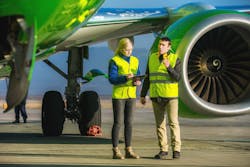The Evolution of Aviation Safety Management

The safety management system (SMS) is fast becoming a global standard in aviation, providing a proactive and structured system to control safety risks in operations. It is currently recognized by the Joint Planning and Development Office (JPDO), International Civil Aviation Organization (ICAO), and numerous civil aviation product and service providers.
The Federal Aviation Administration (FAA) currently requires all Part 121 operators – including U.S. commercial airlines, regional air carriers and cargo operators – to have an SMS in place. However, last January, the FAA introduced a proposed rule to extend this requirement to Part 135 charter, commuter and air tour operators, as well as to aircraft manufacturers holding certification under Part 21.
Historically, the approach to aviation safety was based on the reactive analysis of past accidents and the introduction of corrective actions to prevent the recurrence of those events. An SMS, however, helps organizations proactively identify potential hazards in the operating environment, analyze the risks of those hazards and mitigate those risks to prevent an accident or incident.
In 2015, the FAA promulgated 14 CFR Part 5, which required Part 121 operators to develop and implement an SMS within a three-year period. Its next step is to extend an SMS requirement to additional organizations that play a critical role in the design, manufacturing and operation of aircraft – largely because they are closest to the hazards and in the best position to prevent future incidents and accidents.
The FAA believes the implementation of an SMS by regulators and certificate holders will integrate modern safety risk management and safety assurance concepts into repeatable, proactive systems. An SMS emphasizes safety management as a fundamental business process to be considered in the same manner as other aspects of business management. It provides:
· A structured method of safety risk management decision-making
· A means of demonstrating safety management capability before system failures occur
· Increased confidence in risk controls though structured safety assurance processes
· An effective interface for knowledge sharing between regulators and certificate holders
· A safety promotion framework to support an organization’s sound safety culture
SMS involves the cooperation of all members of an organization, from senior management to line staff. It is a continuous process that aims to improve safety over time. While implementing an SMS requires a significant investment of time and resources, aircraft operators should take the evolution of aviation safety management very seriously.
A combination of factors is contributing to an increased number of aircraft accidents, mishaps and near-misses – causing federal regulators to place a heightened emphasis on aviation safety. Due to a shortage of qualified, trained pilots and air traffic controllers, there are less experienced personnel in both the tower and the cockpit.
For example, in the wake of several fatal accidents involving revenue-generating Part 91 flights, the National Transportation Safety Board (NTSB) has urged the FAA to develop more stringent safety standards for companies offering tour, skydiving, air combat and tourist flights. Specifically, NTSB investigators have discovered a pattern of minimal FAA oversight, insufficient pilot training and maintenance shortfalls when investigating accidents in which people were killed or injured during Part 91 flight operations.
To address these serious safety issues, the FAA is considering a policy that brings revenue-generating Part 91 operators under one national standard, similar to the regulations governing Part 135 operators providing commercial, non-scheduled air charter or taxi flights. For air tour operators, this would include eliminating the current exemption in Part 135 for flights operating within 25 miles of the same airport, as well as requiring safety management systems similar to those required of Part 121 airline operations.
Notably, NTSB data indicates Part 121 airline operations maintain the best safety record in civil aviation, with the Part 135 on-demand air taxi segment holding the next lowest accident rate. In light of these facts, some non-Part 121 operators, maintenance repair and overhaul organizations, and training organizations are taking the steps to develop a voluntary SMS with guidance from the FAA.
A key takeaway is that an organization-wide and preventive approach to managing safety goes beyond the safety policy, processes and performance goals found in a comprehensive SMS. An SMS is intended to be designed and developed by an organization’s own workforce and should be integrated into existing operations and business decision-making processes.
While 14 CFR Part 5 specifies a basic set of processes integral to an effective SMS, it does not provide particular methods for implementing these processes. In simple terms, the FAA defines “what” must be accomplished, but does not define “how” it must be accomplished.
General aviation operators may start developing an SMS by considering these core questions: Do you have an open and non-punitive hazard reporting system? Do you have an organizational culture where all employees feel vested in the shared responsibility of keeping each other, and the equipment they maintain and operate, safe? Are identified hazards dispositioned correctly in terms of root cause and corrective action? How will you measure the effectiveness of the SMS?
An effective, comprehensive SMS requires the engagement and commitment of an organization’s entire workforce at its foundation. A healthy and predictive safety culture rests on every team member feeling empowered to think critically, ask questions, provide recommendations and report safety hazards.
Notably, the terms “safety management” and “safety culture” are often used interchangeably. However, they each serve specific purposes. Understanding where the nuances lie between what makes up safety management and what falls under safety culture will help strengthen both processes for businesses.
Let’s start by looking at how these processes become so inextricably linked. Think of safety management as the foundation that provides a strong, stable base to support the safety culture. The safety culture then reevaluates and repairs the foundation of safety management.
Both safety management and safety culture function with the intention of mitigating injuries and promoting safe working habits. Both safety management and safety culture also utilize a commitment to continuous improvement to make workplaces safer. How each process sets out to achieve these goals varies slightly.
Safety culture and safety management are not mutually exclusive, and organizations should not feel the need to choose one at the expense of the other. Both sets of processes work best when they operate synergistically to create a whole safety program.
Committing to strong safety management overseen by a trusted safety culture will lead to reduced accidents/incidents, more efficient workflows and a more loyal employee base. By empowering a culture of safety with a sound safety management system, you can distinguish your organization as an industry leader in safety.
Curt Castagna, president and CEO of Aeroplex Group Partners, is also president and CEO of the National Air Transportation Association, the chair of the Los Angeles County Airport Commission, and president of the Van Nuys and Long Beach airport associations. A certified private and instrument-rated pilot, he continues to instruct courses in aviation administration at Cypress Community College and Cal State Los Angeles.
About the Author

Curt Castagna
President and CEO
Curt Castagna, President/CEO of Ascension Group Partners, serves as president and CEO of the National Air Transportation Association, member and past chair of the Los Angeles County Airport Commission, and president of the Van Nuys and Long Beach airport associations. A certified private, seaplane and instrument-rated pilot, he continues to instruct courses in aviation administration at Cypress Community College and Cal State Los Angeles.